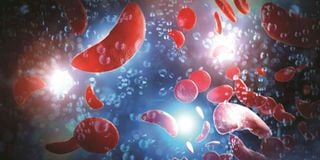Lives at risk as hospitals ran out of sickle cell drugs

Investment in sickle cell disease services can, however, save the lives of thousands of people in Africa.
An irregular supply of Sickle Cell Disease (SCD) management drugs in Kisumu County’s public hospitals has brought misery to patients, who now have to dig deep into their pockets to buy the lifesaving medicines. According to the patients, the county has been grappling with irregular supply of the drugs since the onset of Covid-19 in 2020.
The shortage has been severe over the past three months after a number of public facilities ran out of hydroxyurea and paludrine drugs used for the management of the blood disorder.
“We have been visiting the facilities for our monthly clinical check-ups but instead of getting the doses to take us through 30 days, we only get drugs for 10 days,” said Levil Guda, a sickle cell warrior and advocate.
“On several occasions we are asked to come back but the availability is never guaranteed. We have to go out of our way to purchase these drugs in private pharmacies and chemists at a very high cost,” he added.
He noted that the shortage has had a negative impact on sicklers, especially those living in informal settlements and rural areas.
The SCD management drugs as explained by Sharon Jescah, also a sickler and advocate, goes for Sh40 per tablet. She said a number of caregivers and sicklers are now being forced to spend over Sh1,500 per month to buy the drugs.
This is despite the county having announced plans to provide SCD drugs to patients at a subsidised price following the growing number of sickle cell cases.
“The medicines are key in disease management. We would like the government to look into this matter and help with the supplies to prevent fatalities,” she said.
The sicklers have also decried unavailability of oxygen in various public facilities. Oxygen therapy is beneficial for some patients with sickle cell disease.
Sickle cells block blood flow to organs and deprive the affected organs of blood and oxygen.
“In case of a crisis, one should be placed on oxygen depending on our oxygen levels and some of the facilities completely lack the crucial commodity,” said Sharon.
In 2021, Kisumu Governor Anyang’ Nyong’o announced plans to set up storage plants in sub-county hospitals to utilise the surplus oxygen produced at the Jaramogi Oginga Odinga Teaching and Referral Hospital’s main plant.
The hospitals were to be supplied with 100 cylinders of oxygen per day to limit the number of patients visiting the referral hospital with Covid-19 and other related illnesses.
He revealed that the county had also received a donation of oxygen concentrators through the office of the chief officer, which were transferred to a number of sub-county hospitals.
“We have spoken to the relevant authorities about the shortage on several occasions but nothing good has come out of it. For how long will we lose our loved ones due to lack of oxygen,” Posed Sharon.
Statistics show that a total of 21 out of 100 children in Kisumu are born with the sickle cell trait annually.
Studies have also shown that the Western part of Kenya has a high birth prevalence of SCD at 3.2 per cent to 4.5 per cent.
Further analysis of data at the Jaramogi Oginga Odinga Teaching and Referral Hospital reveals that on average, a sickle cell patient suffers five episodes of crisis annually and 5-10 days of hospitalisation per episode.





